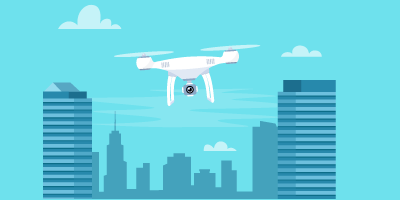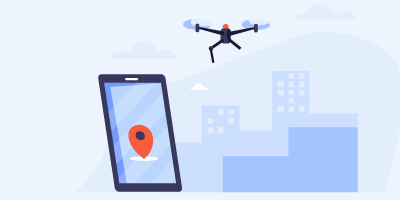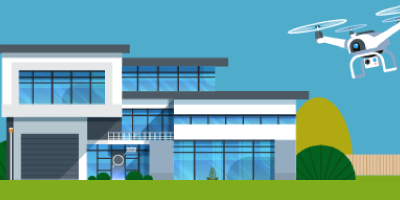New technology in drones is making it possible for civilians, emergency response personnel, and military forces to work together to fight disasters and help save lives. From surveying and mapping disasters to inspections and insurance, there is no doubt that drones will play a huge role in the future of emergency response. In this blog post, we examine how drones are helping disaster relief efforts.
Drones & Fire Disaster Relief
In 2018, wildfires began raging through California. The fires started in early December and destroyed thousands of homes. Drones were used in many different ways during these fires. One way was through aerial data collection. ‘High fire’ risk warnings remained active for weeks in multiple areas in southern California, not allowing anyone to pass through certain areas. The California Air National Guard partnered with the state fire agency CAL FIRE and used drones to collect data that response teams on the ground could not get. They were also able to show firefighters where the fire is moving to cut down on the time it takes to respond.
This video created by C|NET, discusses how drones are helping fire departments in California fight through the long fire season.
DJI did research in Europe in 2016, testing how rescue teams could use drones in response to fires. They found that rescues were much faster when drones were used to help locate people. A bird’s-eye view improves a team’s ability to pinpoint disaster victims and get them support quickly. In urban environments, it is difficult for response teams to get good visuals, and drones make it simple. Also, they help reduce the risk to response teams by keeping them out of harm’s way. Plane and helicopter crashes accounted for nearly a quarter of wild-land firefighter deaths between 2006 and 2016 according to the Forest Service.
Drones & Hurricane Relief
After the hurricanes struck in Texas, Florida, and Puerto Rico, drone pilots took to the skies to help in any way they could. They assisted in tasks from documenting property damage to pinpointing the locations of people in need of rescue, to locating lost pets. During hurricane cleanup efforts in Houston, a team led by Dr. Robin Murphy of Texas A&M University was able to assess flood damage and predict further flooding using drones. The group used many different kinds, including ones that are available to consumers. Emergency response teams are not the only ones using drones for search and rescue. Organizations like DroneUp are mobilizing Part 107 pilots and Part 333 exempt organizations to assist in response efforts. This helped greatly during the 2017 hurricanes to locate people and animals when first responders were stretched thin. The ability to cover a lot of ground remotely made it possible for teams to reach people quickly since the search time was cut down dramatically.
The news clip above is from WAVY-TV, an NBC-affiliated television station serving the Hampton Roads area of southeastern Virginia. This clip discusses how volunteer drone pilots in Texas helped search and rescue operations during hurricane Harvey.
During the response to Hurricanes Harvey and Irma, drones were credited with helping to expedite the search and rescue operations. While the FAA did have to restrict drone operations during the immediate aftermath of the hurricane to make sure that response and recovery aircrafts were unimpeded, they were able to issue authorizations to specific groups to fly. These groups are specifically involved in response and recovery efforts. Some of these authorizations were issued to gas and oil companies who used them to inspect infrastructure, fuel tanks, and power lines.
FAA administrator, Michael Huerta spoke about these response efforts during Interdrone saying, “Essentially, every drone that flew meant that a traditional aircraft was not putting an additional strain on an already fragile system, “I don’t think it’s an exaggeration to say that the hurricane response will be looked back upon as a landmark in the evolution of drone usage in this country.”
The Future of Drones & Disaster Relief
While drones are improving the way that emergency response works, there are still risks to flying during a disaster. Inexperienced or unauthorized pilots can actually impede response efforts and get in the way of teams doing their jobs. Firefighting airplanes and helicopters have run into this problem in the California fires. A warning has been issued by highway patrol to drone operators that the planes cannot fly if the drones are in the air. This creates a risk of collision between manned aircraft and civilian drones. So far, one pilot has been arrested for impeding emergency response after his drone caused firefighting aircrafts to remain grounded for over 10 minutes.
As new drone technology becomes available, we will be able to utilize their technology and design for good.From surveying and mapping disasters to inspections and insurance, drones are the future of emergency response. First responders are testing and talking about the benefits of drone use to aid in many types of disaster relief efforts. As drones build up wind resistance, get better batteries, and better cameras, they will become an integral part of emergency response.
Click here to read how Drones are helping the COVID-19 pandemic
Recent Flights in Drone & Emergency Response
Due to COVID-19, the country of China had to deal with this growing virus in an efficient way. Their response to this: Drones. They communicated with people in the community to inform them that the virus was spreading and also to make sure that they were protecting themselves. This was an effective way to spread information to people without harming others through drones.
Looking for drone services? Our team has captured stunning drone video and photography for businesses throughout the United States. Click below to check out our drone work and services.
Related articles
6 Major Industries That Benefit from Drone Services
A look at how six major industries, such as real estate, eCommerce, and construction, can leverage the benefits of drone services.
Remote ID for Drones: All You Need to Know
In this blog post, we provide a guide to remote ID for drones, including how drone pilots can ensure compliance with the FAA remote ID rule.
Real Estate Drone Photography: Top 3 Benefits and Considerations
In this blog post, we’ll discuss the benefits of real estate drone photography & things realtors should look for when hiring a drone pilot.




